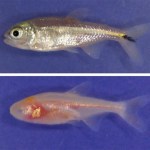blind
Image of cave dwelling Mexican tetra By Citron via Wikimedia Commons
Mexican tetra (Astyanax mexicanus) are a fascinating example of divergent evolution. Over time, some of these freshwater river fish washed into caves where they continue to live. With perpetual darkness, these cavefish have lost their ability to see along with their skin pigmentation. Oxygen and food are also hard to come by in the caves. In fact, the cave dwelling fish may go for months without eating as they wait for seasonal floods to deliver foods. Dr. Cliff Tabin (Harvard Medical School) recently presented his…
Image from LiveScience. Credit: Richard Borowsky
Heat shock protein 90 (HSP90) helps keep proteins in the body folded properly and is thought to compensate for variations that occur in proteins over time. In a study published in Science magazine, Dr. Nicolas Rohner and colleagues showed that stress can affect the ability for HSP90 to do its job thereby unmasking these alternative versions of proteins which may lead to adaptation in some cases.
The theory was tested in fish called Mexican tetra (above), some of which adapted to life in caves leading to eventual loss of, or diminished,…
Image from U Penn.
I came across this really interesting press release from the University of Pennsylvania that I just had to share.
Despite having a close relationship with dogs for thousands of years, we are still making new discoveries about our canine friends. Drs. William Beltran (School of Veterinary Medicine), Artur Cideciyan (Perelman School of Medicine), and colleagues teamed up to study canine eyes in an effort to improve treatments for humans with retinal diseases.
Dr. Beltran was quoted as saying “It’s incredible that in 2014 we can still make an anatomical discovery in a…
The pupils of mice that were injected with the light-sensitive chemical constricted when exposed to bright light (right) in contrast to mice that were not injected (left). Image from Polosukhina et al., 2012.
By injecting the eyes of blind mice with a chemical called AAQ, Dr. Richard Kramer and colleagues at UC Berkeley and the University of Washington have found that the animals are able to detect bright light. When these treated mice were exposed to an LED lamp, they actually turned and ran away from the light. Moreover, their pupils contracted in response to bright light, another…
Not Exactly Pocket Science is a set of shorter write-ups on new stories with links to more detailed takes by the world's best journalists and bloggers. It is meant to complement the usual fare of detailed pieces that are typical for this blog.
Cold-proof tongue allows early chameleon to catch early insect
Chameleons are some of the most versatile of lizards. They live in baking deserts and freezing mountaintops and part of their success hinges on a weapon that works just as well in the warmth as in the cold - its tongue. Relying on stored elastic power for its ballistic strike, the…


